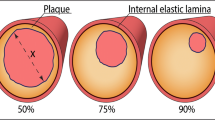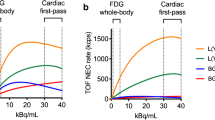Abstract
Introduction The objective of treatment in acute myocardial infarction (AMI) is reperfusion of the myocardium at risk. Our goal was to evaluate the effect of vessel masking on videodensitometric assessment of myocardial reperfusion. Methods Epicardial vessels were masked out from the densitometric region of interest, where average rise slope (G max/T max) of time–density curves (TDC) were measured. Measurements were tested to detect indicators of reperfusion as cumulative creatine-kinase (CK) release and ST-resolution by receiver operating characteristic (ROC) curve analysis. Results When vessel masking was applied before G max/T max measurement, an improvement has been observed in sensitivity and area under ROC curve to detect indicators of reperfusion as cumulative enzyme release (sensitivity (Se): 85% vs. 61%, area under the curve (AUC): 0.84 vs. 0.76) and ST-resolution (Se: 74% vs. 67%, AUC: 0.83 vs. 0.79). Conclusions Selective myocardial perfusion measurement on coronary angiograms is feasible and serves as an informative method to detect myocardial viability after AMI and revascularization therapy. The present study demonstrated that vessel masking improves results compared to simple densitometric analysis.



Similar content being viewed by others
References
Ito H, Tomooka T, Sakai N, Yu H, Higashino Y, Fujii K et al (1992) Lack of myocardial perfusion immediately after successful thrombolysis a predictor of poor recovery of left ventricular function in anterior myocardial infarction. Circulation 85:1699–1705
Ito H, Okamura A, Iwakura K, Masuyama T, Hori M, Takiuchi S et al (1996) Myocardial perfusion patterns related to thrombolysis in myocardial infarction perfusion grades after coronary angioplasty in patients with acute anterior wall myocardial infarction. Circulation 93(11):1993–1999
Wu KC, Zerhouni EA, Judd RM, Lugo-Olivieri CH, Barouch LA, Schulman SP et al (1998) Prognostic significance of microvascular obstruction by magnetic resonance imaging in patients with acute myocardial infarction. Circulation 97(8):765–772
Kondo M, Nakano A, Saito D, Shimono Y (1998) Assessment of “microvascular no-reflow phenomenon” using technetium-99m macroaggregated albumin scintigraphy in patients with acute myocardial infarction. J Am Coll Cardiol 32(4):898–903. doi:10.1016/S0735-1097(98)00435-5
van ’t Hof AW, Liem A, Suryapranata H, Hoorntje JC, de Boer MJ, Zijlstra F (1998) Angiographic assessment of myocardial reperfusion in patients treated with primary angioplasty for acute myocardial infarction: myocardial blush grade Zwolle myocardial infarction study group. Circulation 97:2302–2306
Gibson CM, Cannon CP, Murphy SA, Ryan KA, Mesley R, Marble SJ et al (2000) Relationship of TIMI myocardial perfusion grade to mortality after administration of thrombolytic drugs. Circulation 101:125–130
Pijls NH, Uijen GJ, Hoevelaken A, Arts T, Aengevaeren WR, Bos HS et al (1990) Mean transit time for the assessment of myocardial perfusion by videodensitometry. Circulation 81:1331–1340
Haude M, Caspari G, Baumgart D, Ehring T, Schulz R, Roth T et al (2000) X-ray densitometry for the measurement of regional myocardial perfusion. Basic Res Cardiol 95:261–270. doi:10.1007/s003950050189
Molloi S, Zhou Y, Kassab GS (2004) Regional volumetric coronary blood flow measurement by digital angiography: in vivo validation. Acad Radiol 11:757–766
Korosoglou G, Labadze N, Giannitsis E, Bekeredjian R, Hansen A, Hardt SE et al (2005) Usefulness of real-time myocardial perfusion imaging to evaluate tissue level reperfusion in patients with non-ST-elevation myocardial infarction. Am J Cardiol 95(9):1033–1038. doi:10.1016/j.amjcard.2004.12.055
Korosoglou G, Haars A, Michael G, Erbacher M, Hardt S, Giannitsis E et al (2007) Quantitative evaluation of myocardial blush to assess tissue level reperfusion in patients with acute ST-elevation myocardial infarction: incremental prognostic value compared with visual assessment. Am Heart J 153(4):612–620. doi:10.1016/j.ahj.2006.12.019
Bertomeu-González V, Bodí V, Sanchis J, Núñez J, López-Lereu MP, Peña G et al (2006) Limitations of myocardial blush grade in the evaluation of myocardial perfusion in patients with acute myocardial infarction and TIMI grade 3 flow. Rev Esp Cardiol 59(6):575–581. doi:10.1157/13089745
Galiuto L, Garramone B, Scarà A, Rebuzzi AG, Crea F, La Torre G et al (2008) The extent of microvascular damage during myocardial contrast echocardiography is superior to other known indexes of post-infarct reperfusion in predicting left ventricular remodeling: results of the multicenter AMICI study. J Am Coll Cardiol 51(5):552–559. doi:10.1016/j.jacc.2007.09.051
Kirbas C, Quek F (2004) A review of vessel extraction techniques and algorithms. ACM Comput Surv 36(2):81–121. doi:10.1145/1031120.1031121
Frangi AF, Niessen WJ, Vincken KL, Viergever MA (1998) Multiscale vessel enhancement filtering. Lect Notes Comput Sci 1496:130–137. doi:10.1007/BFb0056195
Costantini CO, Stone GW, Mehran R, Aymong E, Grines CL, Cox DA et al (2004) Frequency, correlates, and clinical implications of myocardial perfusion after primary angioplasty and stenting, with and without glycoprotein IIb/IIIa inhibition, in acute myocardial infarction. J Am Coll Cardiol 44(2):305–312. doi:10.1016/j.jacc.2004.03.058
Prasad A, Stone GW, Stuckey TD, Costantini CO, Zimetbaum PJ, McLaughlin M et al (2005) Impact of diabetes mellitus on myocardial perfusion after primary angioplasty in patients with acute myocardial infarction. J Am Coll Cardiol 45(4):508–514. doi:10.1016/j.jacc.2004.10.054
Silva-Orrego P, Colombo P, Bigi R, Gregori D, Delgado A, Salvade P et al (2006) Thrombus aspiration before primary angioplasty improves myocardial reperfusion in acute myocardial infarction: the DEAR-MI (dethrombosis to enhance acute reperfusion in myocardial infarction) study. J Am Coll Cardiol 48(8):1552–1559. doi:10.1016/j.jacc.2006.03.068
Young JJ, Cox DA, Stuckey T, Babb J, Turco M, Lansky AJ et al (2007) Prospective, multicenter study of thrombectomy in patients with acute myocardial infarction: the X-tract AMI registry. J Interv Cardiol 20(1):44–50. doi:10.1111/j.1540-8183.2007.00223.x
Cura FA, Escudero AG, Berrocal D, Mendiz O, Trivi MS, Fernandez J et al (2007) Protection of distal embolization in high-risk patients with acute ST-segment elevation myocardial infarction (PREMIAR). Am J Cardiol 99(3):357–363. doi:10.1016/j.amjcard.2006.08.038
Bucciarelli-Ducci C, Bianchi M, De Luca L, Battagliese A, Di Russo C, Proietti P et al (2006) Effects of glucose–insulin–potassium infusion on myocardial perfusion and left ventricular remodeling in patients treated with primary angioplasty for ST-elevation acute myocardial infarction. Am J Cardiol 98(10):1349–1353. doi:10.1016/j.amjcard.2006.06.025
Eigler NL, Pfaff JM, Zeiher A, Whiting JS, Forrester JS (1989) Digital angiographic impulse response analysis of regional myocardial perfusion: linearity, reproducibility, accuracy, and comparison with conventional indicator dilution curve parameters in phantom and canine models. Circ Res 64(5):853–866
Cannon RO III, Epstein SE (1988) “Microvascular angina” as a cause of chest pain with angiographically normal coronary arteries. Am J Cardiol 61(15):1338–1343. doi:10.1016/0002-9149(88)91180-0
Acknowledgements
This study was financially supported by the Regional Cooperative Research Center of Life and Material Sciences of the University of Szeged (DEAK) and GE Healthcare, Hungary. Dr. Tamás Ungi holds a PhD scholarship of the University of Szeged.
Author information
Authors and Affiliations
Corresponding author
Rights and permissions
About this article
Cite this article
Ungi, T., Zimmermann, Z., Balázs, E. et al. Vessel masking improves densitometric myocardial perfusion assessment. Int J Cardiovasc Imaging 25, 229–236 (2009). https://doi.org/10.1007/s10554-008-9374-5
Received:
Accepted:
Published:
Issue Date:
DOI: https://doi.org/10.1007/s10554-008-9374-5




